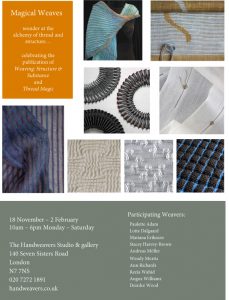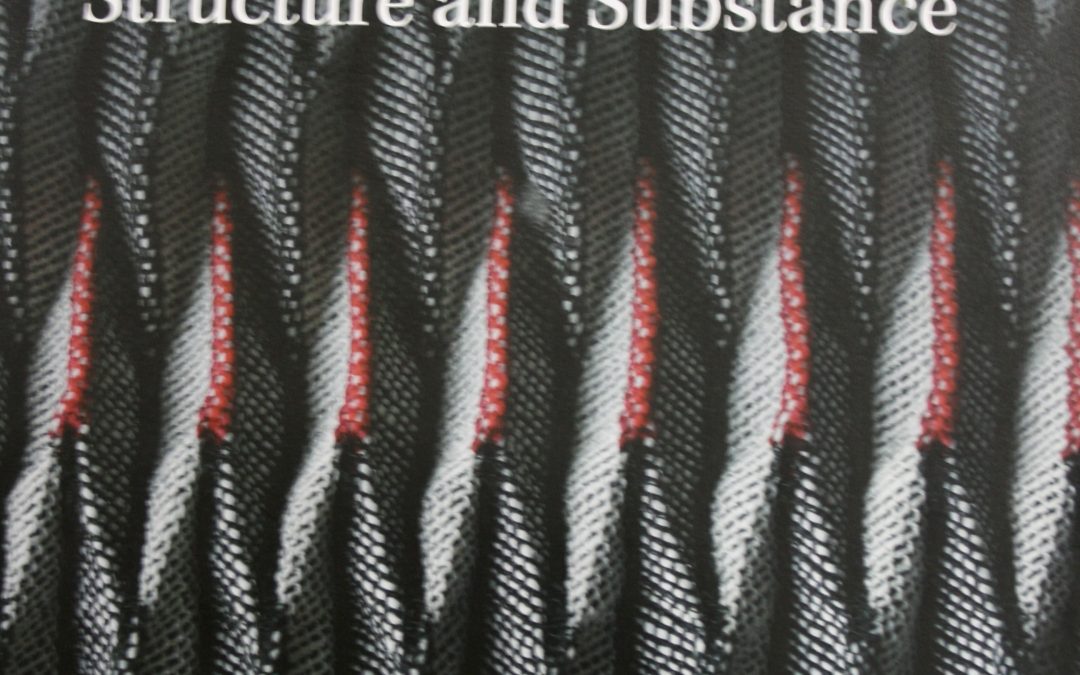This is a book any weaver serious about developing their own weaving and wanting to understand more about weave structure should add to their library.
A bit strong as an opening sentence? Well, I suggest you get a copy and see for yourself! I loved it. It’s a treat for new and experienced weavers alike. Ann includes lots of basic structure information but with historical context and development which makes it so much more relevant. It’s worth reading this book from cover to cover as Ann goes into details and explanations which helped fill a few gaps in my knowledge and which are clear, descriptive and never preachy.
There are four sections to the book – 1) Nature as Designer. 2) Resources for Design. 3) Designing for Fabric Qualities. 4) Designing Through Making
- Nature as Designer includes many references to authors outside the weaving genre, such as D’Arcy Thompson, James Gleick and Clifford Pickover, to mention just three! It’s not surprising that D’Arcy Thompson is in there as Ann was a biologist in her previous life, but it’s lovely to find other science and mathematics writers included too, and the Bibliography contains a few books I’m going to be investigating further!!
- Resources for Design includes a lot of information on materials before moving on to structure and exploring materials and structure and touching on colour. I’m a firm believer in learning by analysing existing fabrics – you learn so much by close examination and trying to notate the weave draft from dissecting fabrics – and there is a really useful guide to fabric analysis in chapter 4. If you’ve not tried this technique before, I would encourage you to have a go. It can feel like you’re a cloth detective, uncovering clues as to the origins of the weave structure, yarns, materials and twist. Think of it as tracing the fabric’s family tree – an Ancestry of Fabric!
- Designing for Fabric Qualities includes pleating, transparency, double-sided fabrics (both single and multiple layers) and distorting the weaving grid, including shaping cloth through the use of specific weave structures and yarns.
- I particularly enjoyed this part of the book as reflective making is something that I see as essential for weavers who wish to design original fabrics and not just to copy. Sampling is something that many people avoid, but it gives you the freedom to play and experiment without necessarily having any set outcome so that happy accidents are welcomed and not seen as something to eradicate the moment they are noticed. I hope that readers of this section are encouraged to explore and experiment more, to respond to what the materials, structures, colour blends and wet-finishing tells us so that we can learn, adapt and create extraordinary, personal and original fabrics as shown by so many of the images in the book.
I’d like to quote Ann from the last chapter of the book – “Plans are useful resources but successful design also requires a responsiveness to the interplay of material and structure that may throw up unexpected problems of possibilities that could not have been predicted – designing through making is an emerging process.”

If I have one quibble, it’s that some sections felt as if they had been written separately and then slotted in, with duplicated content (but not literally copied and pasted) but this could be to assist people who wish to dip into the book at a specific chapter rather than reading it from front to back, so it could just be that I am using it in a different way to most. It could also be more of an editorial decision rather than the author’s one and it might also be worth remembering that readers of different levels of experience will be reading the book and it is trying to cater for the majority.
That aside, this is a book that will enrich any reader who approaches it with an open mind wanting to learn more and be open to ways of designing that may not be in their regular mode of weaving. I’ll be returning to it often!
There’s currently an exhibition (see flyer to the right – 18th November – 2 February) of some of the work included in the book at Handweavers’ Studio and Gallery, 140 Seven Sisters Road, London N7 7NS. 020 7272 1891
ISBN: 978-1-78500-929-7. Published by The Crowood Press. £25.

